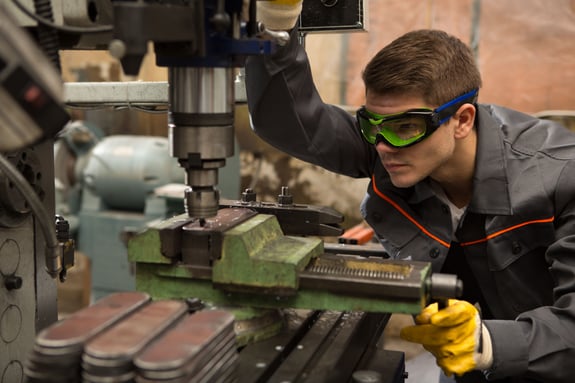
So the question is —does it really matter if safety glasses or goggles actually fit the person wearing them?
Now take a minute and really think about. We’ll wait.
Hopefully it didn’t take too long to think that one through. We are talking about the face and eyeballs here. You’re damn straight, it’s important that you supply your workers with protection that fits them. What’s the point of providing inefficient protection? You’re not protecting workers and it’s not really saving your budget? It’s all fun and games until you get a stick in the eye… and a lawsuit on your shoulders.
Don’t half-ass it with safety. One size fits all for eye protection is about as useful as a snooze button on a smoke alarm.
We can take shortcuts on a lot of things, but safety isn’t one of them. The reality is that a person’s gender, weight, age, bone structure and ethnicity can all impact the size and shape of their face. They even have children’s safety glasses that are smaller than adult size glasses.
The reason for this: if any kind of safety equipment doesn’t fit properly, it won’t protect and workers will not wear them. Period!
Here are some things to avoid:
- Discomfort: Look for padded temples that provide tension and flex to provide workers with the most comfortable fit possible
- Gaps around eyewear: Debris, particulates and UV radiation can enter the eyes and cause injury when there are gaps above, below or on the sides of eyewear
- Choose safety glasses that workers can add or remove foam padding to customize the fit to their own needs
- If working with chemicals, make sure workers have lightweight and comfortable goggles that give them a complete seal. Don’t use foam inserts in this application, the chemicals can soak right in
- Choose safety glasses that workers can add or remove foam padding to customize the fit to their own needs
- Fogging: If a worker is constantly clearing condensation off their glasses, it can lead to worker distraction and removal of eyewear at the very least. If a worker has to remove their safety gear for any reason to do their job, it’s the wrong PPE
Let’s put this in perspective: What do you think could happen if a worker can’t see clearly when they are working with dangerous machinery or in dangerous environments?
- Slipping: This one is pretty simple. If a worker is constantly readjusting their glasses, how long do you think they are going to keep them on? Chances are they are going to end up in a toolbox or center console, doing absolutely no good.
You know OSHA has a few things to say about Eye Protection. Here it is:
OSHA29 CFR 1910.133(a)(1)
“The employer shall ensure that each affected employee uses appropriate eye or face protection when exposed to eye or face hazards from flying particles, molten metal, liquid chemicals, acids or caustic liquids, chemical gases or vapors, or potentially injurious light radiation”
Not only does safety eyewear need to meet OSHA regulations, it needs to meet ANSI Z87.1+ standards for impact resistance. Another thing to look for, has the manufacturer had a 3rd party test to back up its claims? You need to be careful when it comes to safety equipment, especially safety eyewear. We have knockoffs coming at us from every direction. Choose one that isn’t tested and approved and you might as well rely on blinking for protection—you know, nature’s windshield.
.jpg?width=366&height=183&name=shutterstock_593322020%20(1).jpg)
How many people need to lose their vision before we get this right? Well, OSHA estimates that number is in the thousands every year. And more than 700,000 Americans injure their eyes at work each year. Let’s be honest, something ain’t jiving when you have that many recordables every year.
Now that you’ve chosen safety glasses or goggles that fit your crew, you’re done right?
Nope. It doesn’t end there. Make sure you train workers on identifying hazards on the job so that they actually know why you are making them wear PPE. And because the work you do is often tough, expect to have to provide repairs and replacement for damaged eyewear. Broken or inadequate protection is worse than no protection at all, because of the false sense of security it gives your worker.
And when all else fails, make sure you have an emergency eyewash station set up for any contact with harmful dust, debris or chemical splash. Seconds matter when it comes to first aid and saving a worker’s eyesight. Not sure exactly how this info applies to your job site? Need help choosing safety eyewear? The Quad City Safety pros are just a click away.
Don’t worry. If you decide not to do any of these things, you can still hire someone to come out and make all your safety signs in Braille!
Do you have some crazy stories to share about workers not wearing the right eye protection? Feel free to share in the comments below!
Safety: It's Your Life, It's Our Business








